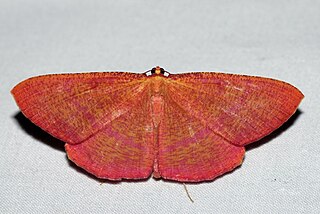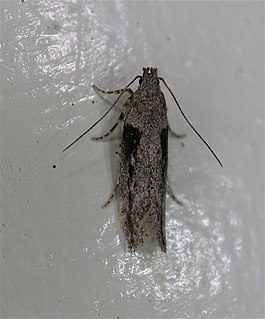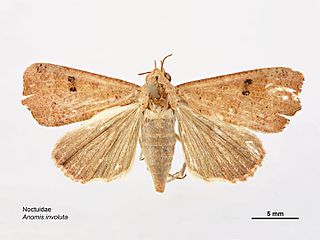
The geometer moths are moths belonging to the family Geometridae of the insect order Lepidoptera, the moths and butterflies. Their scientific name derives from the Ancient Greek geo γεω, and metron μέτρον "measure" in reference to the way their larvae, or inchworms, appear to measure the earth as they move along in a looping fashion. A very large family, it has around 23,000 species of moths described, and over 1400 species from six subfamilies indigenous to North America alone. A well-known member is the peppered moth, Biston betularia, which has been subject of numerous studies in population genetics. Several other geometer moths are notorious pests.

The bogong moth is a temperate species of night-flying moth, notable for its biannual long-distance seasonal migrations towards and from the Australian Alps, similar to the diurnal monarch butterfly. During the autumn and winter it is found in southern Queensland, western New South Wales, western Victoria, and also in South and Western Australia. Adult bogong moths breed and larvae hatch during this period, consuming winter pasture plants during their growth. During the spring, the moths migrate south or east and reside in mountains such as Mount Bogong, where they gregariously aestivate over the summer until their return towards breeding grounds again in the autumn.

Nepticulidae is a family of very small moths with a worldwide distribution. They are characterised by eyecaps over the eyes. These pigmy moths or midget moths, as they are commonly known, include the smallest of all living moths, with a wingspan that can be as little as 3 mm in the case of the European pigmy sorrel moth, but more usually 3.5–10 mm. The wings of adult moths are narrow and lanceolate, sometimes with metallic markings, and with the venation very simplified compared to most other moths.

Epermeniidae or the fringe-tufted moths is a family of insects in the lepidopteran order with about 14 genera. Previously they have been divided in two subfamilies Epermeniinae and Ochromolopinae but this is no longer maintained since the last group is probably hierarchically nested within the first. They are presently placed in their own superfamily but have previously been placed among the Yponomeutoidea or Copromorphoidea with which they share some features. Their systematic placement among the apoditrysian group "Obtectomera" is however uncertain. They show some morphological similarities to the "plume moths", for example the wing fringe has similar groups of scales. There are also some similarities to Schreckensteinioidea, for example spiny legs and at least in some species an open-network cocoon. The genus Thambotricha from New Zealand may be the sister group of all other extant members. The most important genera are Epermenia, Ochromolopis and Gnathifera. The group has been extensively revised and catalogued by Dr Reinhard Gaedike.

Ennominae is the largest subfamily of the geometer moth family (Geometridae) with some 9,700 described species in 1,100 genera. They are usually a fairly small moths, though some grow to be considerably large. This subfamily has a global distribution. It includes some species that are notorious defoliating pests. The subfamily was first described by Philogène Auguste Joseph Duponchel in 1845.

Spoladea recurvalis, the beet webworm moth or Hawaiian beet webworm, is a species of moth of the family Crambidae. It is found worldwide, but mainly in the tropics.

Oenosandra is a monotypic moth genus in the family Oenosandridae. Its only species, Oenosandra boisduvalii, or Boisduval's autumn moth, is found in the southern half of Australia, including Tasmania. Both the genus and species were first described by Edward Newman in 1856.

Anthela nicothoe, the urticating anthelid, is a moth of the family Anthelidae.

Erechthias mystacinella, the curve-winged apple moth, is a moth of the family Tineidae. It is found in the Australian Capital Territory, Tasmania and Victoria.

Arhodia is a monotypic moth genus in the family Geometridae. Its only species, Arhodia lasiocamparia, the pink arhodia, is found in mainland Australia and Tasmania. Both the genus and species were first described by Achille Guenée in 1857.

Abantiades latipennis, known as the Pindi moth, is a species of moth in the family Hepialidae. It may also be referred to as a swift moth or a ghost moth, as this is a common name associated with Hepialidae. Endemic to Australia and identified in 1932, it is most populous in temperate rainforest where eucalypti are prevalent, as the larvae feed primarily on the roots of these trees. Females lay eggs during flight in a scattering fashion. The larvae live for over eighteen months underground, while adult moths survive for approximately one week, as they have no mouthparts with which to feed. The moths are preyed upon by a number of predators, including bats and owls. Brown in colour overall, males are paler and the identifying silver bars of the male's wings are more prominent than those of the female's, with dark margins. Male adults are generally smaller.

Phelotis is a monotypic moth genus in the family Geometridae erected by Edward Guest in 1887. Its single species, Phelotis cognata, the long-fringed bark moth, first described by Francis Walker in 1860, is found in Australia.

Panacela lewinae, or Lewin's bag shelter moth, is a moth of the family Eupterotidae. The species was first described by John Lewin in 1805. It is found in Australia from southern Queensland to southern New South Wales.

Eumelea rosalia is a species of moth of the family Geometridae described by Caspar Stoll in 1781. It is found from the Indo-Australian tropics of India, Sri Lanka, Myanmar, east to northern Australia and New Caledonia.

The South American potato tuber moth, Andean potato tuber moth or tomato stemborer is a moth of the family Gelechiidae. It is native to South America, but has become a pest worldwide. Records include North America, Australia and New Zealand.

Pollanisus viridipulverulenta, the satin-green forester, is a moth of the family Zygaenidae. It is found in the eastern part of Australia.

Hellula undalis, the cabbage webworm or Old World webworm, is a moth of the family Crambidae. It is a widespread species which is found from Europe across Asia to the Pacific. It was first described from Italy.

Pyralis manihotalis is a moth of the family Pyralidae described by Achille Guenée in 1854.

Grapholita molesta, the oriental fruit moth or peach moth, is a moth of the family Tortricidae. It is native to China, but was introduced to Japan and North America and is now also found throughout of Europe, Asia and South America and in Hawaii, Morocco, Mauritius, South Africa, Australia and New Zealand

Anomis involuta, the jute looper or hibiscus cutworm, is a moth of the family Erebidae. It has a wide distribution, including the Cook Islands, Hong Kong, Japan, Korea, the Society Islands and Australia. It is also known from Kenya and Somalia.



















